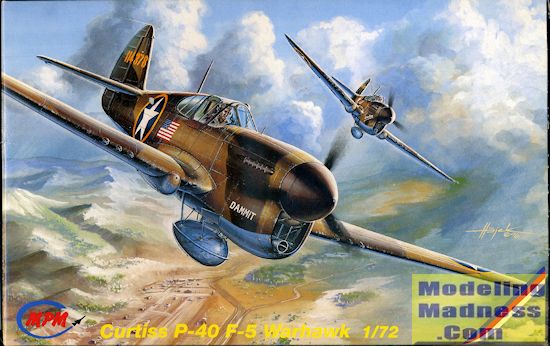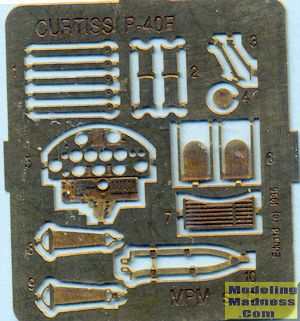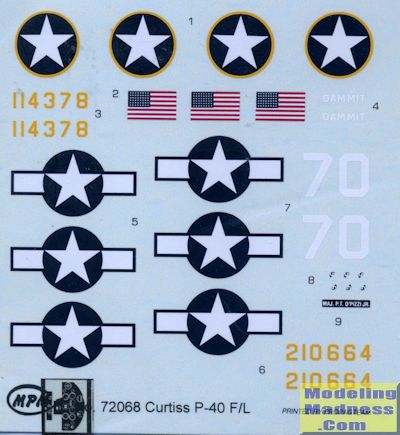
| KIT #: | 72068 |
| PRICE: | mine was $5.00 from a vendor |
| DECALS: | Two options |
| REVIEWER: | Scott Van Aken |
| NOTES: | Short run kit with etched fret and vacuformed clear pieces. |

| HISTORY |
In an attempt to improve altitude performance, the P-40F and P-40L were developed, which both featured a Packard V-1650 Merlin engine in place of the normal Allison, and thus did not have the carburetor scoop on top of the nose. Performance for these models at higher altitudes was better than their Allison-engined cousins. The first 500 P-40Fs had a standard tail section, but later versions, in an attempt to improve directional stability, had a longer fuselage which pushed the fin farther back. The L in some cases also featured a fillet in front of the vertical stabilizer, or a stretched fuselage to compensate for the higher torque. The P-40L was sometimes nicknamed "Gypsy Rose Lee", after a famous stripper of the era, due to its stripped-down condition. Supplied to the Commonwealth air forces under the designation Kittyhawk Mk II, a total of 330 Mk IIs were supplied to the RAF under Lend-Lease. The first 230 aircraft are sometimes known as the Kittyhawk Mk IIA. The P-40F/L was extensively used by U.S. fighter groups operating in the Mediterranean Theater.
| THE KIT |
 Over
the years we have had fairly nice models of the Alison engine P-40. However,
the Merlin powered variant has been relatively ignored in all scales. In
1/72 in particular, there has been only conversions for the Hasegawa kit
that provided a new nose. It has been left up to short run kits to provide
an F.
Over
the years we have had fairly nice models of the Alison engine P-40. However,
the Merlin powered variant has been relatively ignored in all scales. In
1/72 in particular, there has been only conversions for the Hasegawa kit
that provided a new nose. It has been left up to short run kits to provide
an F.
This offering from MPM is not one of their
newer kits. It harkens back to their early days and while not the short run
type on a radial sprue, is not far removed. The surface detailing is best
described as being petite and will quickly disappear under any sanding.
and will quickly disappear under any sanding.
One should not let the single sprue lull one into confidence that this will be an easy build. It will probably be not. There is a cockpit floor with molded on rudder pedals and a control stick. The instrument panel includes an acetate sheet for instruments and the p.e. rudder pedals attach to it. The seat includes p.e. seat harness items. This fits to the rear cockpit bulkhead which then glues to the floor. There is no interior fuselage sidewall detail. In fact, as with most large parts, there are small ejector towers to be removed. The nose radiator piece has two photo etch pieces for the carb and coolant intakes. This is all trapped between the fuselage halves.
The wings are a single lower piece with guns on the centerline of the leading edge (which we now know is wrong). A flat wheel well piece with 'detail' is then placed over the wheel openings and the upper wings are attached. Guaranteed that the trailing edges of the wings will be thick. One then butt joins the fin and stabilizers to the rear of the fuselage before joining the wing to the lower fuselage. For clear bits, you have two small rear quarter windows on one sheet and the windscreen/canopy on the other.
 Gear are
fairly well done with photo etch for the main gear retraction struts and
oleo scissors. The gear doors on the tail gear will need to be cut. Main
wheels are in halves while the tail wheel is molded on the strut. There is a
centerline fuel tank with braces. The prop is a single piece and is trapped
between the spinner and backing section. Small items like the pitot tube
will have to be manufactured by the builder.
Gear are
fairly well done with photo etch for the main gear retraction struts and
oleo scissors. The gear doors on the tail gear will need to be cut. Main
wheels are in halves while the tail wheel is molded on the strut. There is a
centerline fuel tank with braces. The prop is a single piece and is trapped
between the spinner and backing section. Small items like the pitot tube
will have to be manufactured by the builder.
Instructions are nicely drawn and include Humbrol paint numbers. For the exterior a name is provided for the colors as well. Both markings options are in dark earth/middlestone over azure blue The box art plane is one based in Oran in December 1942 and named 'Dammit'. Typical of the planes flown from carrier decks to their bases, this plane has the yellow surround insignia and the large American flags. The other plane is from the 316th squadron based at Fogia in 1943. This one has a red spinner, the later insignia, and large patches of olive drab on the forward cowling, fuselage and the fin/rudder. Decals are nicely done and printed by Propagteam.
| CONCLUSIONS |
Though perhaps not the perfect 1/72 P-40F, it is a Merlin powered plane, of which there are not many others if any in this scale. I'd consider this a second generation short run kit that will require some work and skill on the part of the builder, but a nice model should result from careful building.
| REFERENCES |
https://en.wikipedia.org/wiki/Curtiss_P-40_Warhawk
October 2015
Thanks to me for the preview kit. If you would like your product reviewed fairly and fairly quickly, please contact the editor or see other details in the Note to Contributors.